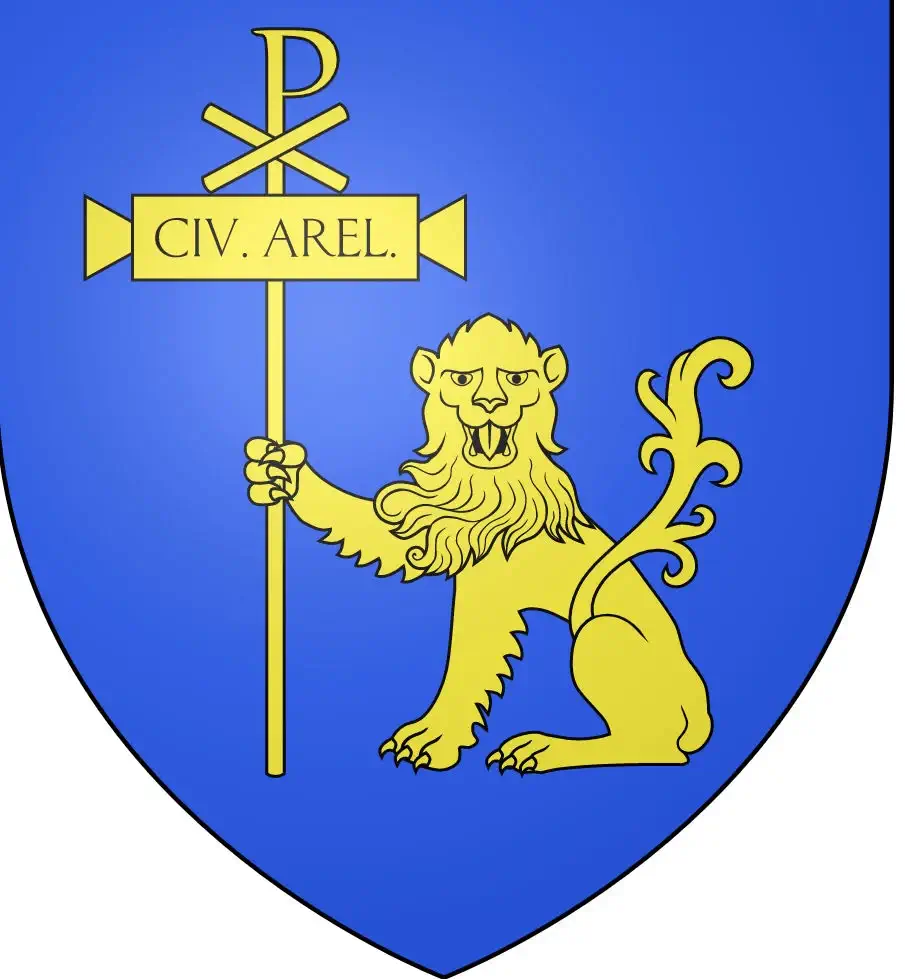by Celeste Lipford and Terry Lipford - last updated on 5/17/2025

We were onboard a Viking River Cruise (click here to view our Trip Overview Page or click here to view the Viking River Cruises Avignon & Provence information) and Arles was the first stop after Avignon. The ship moved from Avignon, south to Tarascon at 5AM (approximately 30 kilometers), so that the day's tour to Arles could begin from there. The tour to Arles was via tour bus, so moving the ship closer made the bus route shorter.
The town of Arles is a charming community located in the Provence-Alpes-Côte d'Azur region in southeastern France (click the map link above to view a larger Google Map). Located near the Mediterranean coast, it is a popular destination for tourists drawn to its rich history, vibrant culture, and proximity to scenic seaside landscapes. Arles was originally founded by the Ligurians and later flourished during Roman times as an essential port and commercial hub along the Rhône River.

The town is renowned for its well-preserved Roman monuments, many of which are UNESCO World Heritage Sites. Visitors can marvel at the grand Arènes d'Arles, an ancient amphitheater that still hosts performances and events today, as well as remnants of the Roman aqueduct and the Thermae of Constantine.
In addition to its historical treasures, Arles boasts a thriving arts scene and is famously associated with Vincent van Gogh, who produced some of his most iconic works during his stay here.
Click here to go to the Arles Wikipedia page.
The Ligurians were in the Arles area from about 800 BC. Later, Celtic influences have been discovered. The city became an important Phoenician trading port, before being taken by the Romans early in the first century BCE.
Yes, the Roman and Romanesque Monuments of Arles were listed as UNESCO World Heritage Sites in 1981.
Yes, Vincent van Gogh lived in Arles from 1888 to 1889 and created some of his most iconic paintings there, including “Starry Night Over the Rhône” and “The Yellow House”.
Arles is twinned with: Pskov, Russia; Jerez de la Frontera and Cubelles, Spain; Fulda, Germany; York, Pennsylvania, United States; Vercelli, Italy; Sagné, Mauritania; Kalymnos, Greece; Wisbech, United Kingdom; Zhouzhuang, Kunshan, Jiangsu, People’s Republic of China; Verviers, Belgium & George Town, Penang, Malaysia.
Yes, Arles hosts Les Rencontres d’Arles, one of the most prestigious international photography festivals in the world, attracting artists and audiences every summer since 1970.
Yes, Arles enjoys over 300 days of sunshine per year, which was part of what drew Van Gogh — and continues to draw visitors seeking Provençal warmth and light.
As of the most recent data (2021), the population of Arles, France is approximately 49,000 residents.
Yes, Arles is the largest commune in France in terms of territory.
Arles has a diverse local economy, with industries rooted in agriculture, tourism, culture, and small-scale manufacturing, as well as its proximity to natural resources and regional infrastructure. The major French publishing house Actes Sud is also situated in Arles. It was founded in 1978 by author Hubert Nyssen.
This was our first group exploration stop. This two-tiered Roman amphitheatre is probably the most prominent tourist attraction in the city. The pronounced towers jutting out from the top are medieval add-ons.
Built in 90 AD, the amphitheatre was capable of seating over 20,000 spectators, and was built to provide entertainment in the form of chariot races and bloody hand-to-hand battles. Today, it draws large crowds for bullfighting during the Feria d'Arles as well as plays and concerts during the summer.
Today, the Arles Roman Amphitheatre is a UNESCO World Heritage Site and a symbol of the enduring legacy of Roman civilization. It continues to captivate visitors with its historical significance, architectural splendor, and the cultural events it hosts, such as concerts and bullfights, making it a must-visit attraction for those interested in the rich history of the Roman Empire.
Image # 6 (arena interior) is the property of Jmalik via Wikimedia Commons. All other images are the property of Just Traveling Thru, LLC unless otherwise noted.
This site, now known as "L'espace Van Gogh," was once the hospital where Vincent van Gogh stayed during December 1888 and January 1889 after the infamous incident in which he mutilated his ear. Though no longer a functioning hospital, the building and its courtyard remain well-preserved, and the grounds are as beautiful as ever, with vibrant flower beds that echo the colors van Gogh captured in his paintings.
Arles was a profound source of inspiration for van Gogh. The town’s unique architecture, bustling streets, and surrounding landscapes offered endless material for his work. He immortalized the Rhône River, the charming cafes, the vibrant marketplace, and, of course, the iconic fields of sunflowers that stretch beyond the horizon.
Despite the creative explosion he experienced in Arles, van Gogh faced significant personal struggles, including his deteriorating mental health and a turbulent relationship with fellow artist Paul Gauguin. Yet, this challenging period yielded some of his most groundbreaking pieces, including "The Night Café," "Bedroom in Arles," and "Starry Night Over the Rhône."
During his 15 months in Arles, van Gogh completed over 200 paintings and more than 100 drawings and watercolors, making it one of the most prolific and influential chapters of his career.
Van Gogh's stay at the Arles Hospital
Van Gogh's mental health deteriorated and he became alarmingly eccentric, culminating in an altercation with Paul Gauguin in December 1888 following which van Gogh cut off part of his own left ear. He was then hospitalized in Arles twice over a few months. His condition was diagnosed by the hospital as "acute mania with generalised delirium". Dr. Félix Rey, a young intern at the hospital, also suggested there might be "a kind of epilepsy" involved that he characterised as mental epilepsy. Although some, such as Johanna van Gogh, Paul Signac and posthumous speculation by doctors Doiteau & Leroy have said that van Gogh just removed part of his earlobe and maybe a little more, art historian Rita Wildegans maintains that without exception, all of the witnesses from Arles said that he removed the entire left ear.
In January 1889, Van Gogh returned to the Yellow House where he was living, but spent the following month between hospital and home suffering from hallucinations and delusions that he was being poisoned. In March 1889, the police closed his house after a petition by 30 townspeople, who called him "fou roux" (the redheaded madman). Signac visited him in hospital and van Gogh was allowed home in his company. In April 1889, he moved into rooms owned by Dr. Félix Rey, after floods damaged paintings in his own home. Around this time, he wrote, "Sometimes moods of indescribable anguish, sometimes moments when the veil of time and fatality of circumstances seemed to be torn apart for an instant." Finally in May 1889 he left Arles for the Saint-Paul asylum in Saint-Rémy-de-Provence, having understood his own mental fragility and with a desire to leave Arles.
Image # 5 above is the property of Marianne Casamance via Wikimedia Commons using the CC BY-SA 3.0 License.
All other images, unless otherwise noted, are the property of Just Traveling Thru, LLC.
The 50 foot obelisk in front of the building, was first erected under the Roman emperor Constantine II in the center of the spina of the Roman circus of Arles. After the circus was abandoned in the 6th century, the obelisk fell down and was broken in two parts. It was rediscovered in the 14th century and re-erected on top of a pedestal soon surmounted by a bronze globe and sun on March 26, 1676.
We had a light snack while hoofing about Arles, because we knew that lunch aboard the ship was going to be another great meal! The tour bus returned us to the ship for lunch, and we decided to not take the optional afternoon tour to St. Remy and instead hung out and worked on further jet-lag removal (AKA "nap").
The following list contains links to all of our other French Destinations & Information Pages, click any link to go to that page.
Note: All images featured on this page are the exclusive property of Just Traveling Thru, LLC, unless otherwise stated. When images from external sources are used, full credit is given to the original creator, along with a link to the specified license or usage terms. We are committed to respecting copyright and intellectual property rights, ensuring that all third-party images are properly attributed. If you have any questions regarding image ownership or usage rights, please feel free to contact us.
Affiliate Links: We may earn a commission if you make a purchase through one of our affiliate links. This helps support our travel content — thank you!
Content: To review any of our content, make suggestions and/or comments, please click the "About" menu link at the top of this page. You will find our "Contact Us" link on that drop-down menu.